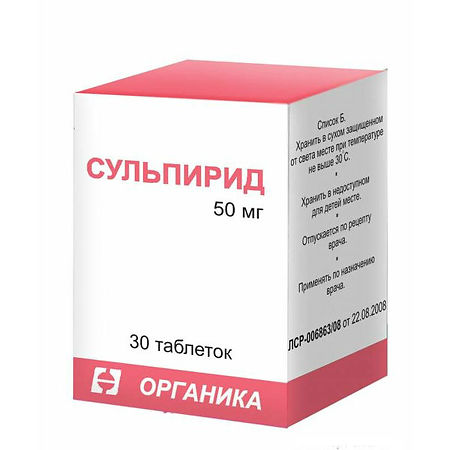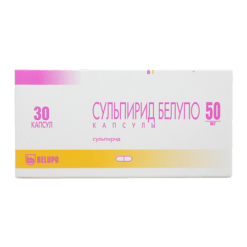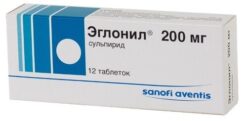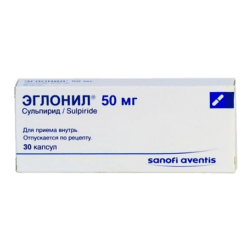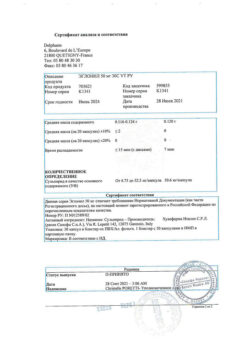No products in the cart.
Sulpiride, tablets 50 mg, 30 pcs.
€1.00
Out of stock
(E-mail when Stock is available)
Description
Sulpiride is an atypical neuroleptic from the group of substituted benzamides.
Sulpiride has moderate neuroleptic activity combined with stimulant and thymoanaleptic (antidepressant) action.
The neuroleptic effect is associated with antidopaminergic action. In CNS sulpiride blocks mainly dopaminergic receptors of limbic system and has little effect on neostriate system, it has antipsychotic effect and causes few side effects.
Peripheral action of sulpiride is based on inhibition of presynaptic receptors. An increase in the amount of dopamine in the CNS is associated with improvement of mood, with a decrease – development of depression symptoms.
Antipsychotic effect of sulpiride is seen in doses over 600 mg/day, in doses up to 600 mg/day the stimulant and antidepressant effects predominate.
Sulpiride has no significant effect on adrenergic, cholinergic, serotonin, histamine and GABA receptors.
In small doses sulpiride can be used as adjuvant in treatment of psychosomatic diseases, in particular, it is effective in relieving negative psychic symptoms of gastric and duodenal ulcer. In irritable colon syndrome sulpiride reduces the intensity of abdominal pain and leads to improvement of clinical condition of the patient.
Low doses of sulpiride (50-300 mg/day) are effective for dizziness, regardless of the etiology. Sulpiride stimulates prolactin secretion and has a central antiemetic effect (inhibition of the vomiting center).
Pharmacokinetics
After oral administration Cmax in plasma is reached after 1.5-3 hours. Bioavailability of sulpiride is 27%. Sulpiride binding to plasma proteins is less than 40%. Concentration of sulpiride in CNS is 2-5% of plasma concentration. Sulpiride is excreted with breast milk. Sulpiride is not metabolized in the human body and is excreted almost unchanged through the kidneys. T1/2 is 6-8 h. T1/2 is significantly increased in patients with moderate to severe renal impairment up to 20-26 h after IV administration. Such patients should reduce the dose of sulpiride and/or increase the interval between doses of the drug.
Indications
Indications
As monotherapy or in combination with other psychotropic drugs.
Active ingredient
Active ingredient
Composition
Composition
1 tablet contains:
active ingredients: sulpiride 50 mg;
excipients: lactose (milk sugar); potato starch; MCC; gelatin; talc; magnesium stearate (magnesium stearate).
How to take, the dosage
How to take, the dosage
Acute and chronic schizophrenia, acute delirium psychosis: initial doses depend on the clinical picture of the disease and are 600-1200 mg daily divided into several doses; maintenance doses are 300-800 mg daily.
Depression: from 150-200 mg to 600 mg per day, divided into several doses.
Dizziness: 150-200 mg per day, in severe states the dose can be increased to 300-400 mg. The duration of treatment is at least 14 days.
Auxiliary therapy in gastric and duodenal ulcer disease, irritable colon syndrome: 100-300 mg per day, in 1 or 2 doses.
Dosages in patients with impaired renal function
In view of the fact that sulpiride is mainly excreted through the kidneys, it is recommended to decrease the dose and/or increase the interval between administering individual doses of the drug, depending on creatinine clearance rates:
Creatinine clearance, mL/minDose of sulpiride versus standard, % Increase interval between doses of sulpiride30-6070 1.5 times10-3050 2 times less than 1030 3 times
Doses for the elderly: the starting dose should be 1/4-1/2 of the adult dose.
Doses for children: The standard dose for children over 14 years of age is 3-5 mg/kg body weight.
Interaction
Interaction
Simultaneous administration of sulpiride and CNS depressant drugs (narcotic analgesics, antihistamines, barbiturates, benzodiazepines and other anxiolytics) may increase the sedative effect of these drugs.
Combination of sulpiride with alcohol may also increase the sedative effect of alcohol.
Concomitant administration with levodopa should be avoided because of mutual antagonism of levodopa and sulpiride.
There is an increased risk of orthostatic hypotension when sulpiride and antihypertensive agents are taken concomitantly.
Sucralfate, antacids containing Mg2+and/or Al3+ reduce bioavailability by 20-40%.
Antagonism with dopaminergic receptor agonists (amantadine, apomorphine, bromocriptine, cabergoline, entacapone, lisuride, pergolide, pyribedil, pramipexole, quinagolide, ropinirole) and neuroleptics. In extrapyramidal syndrome induced by neuroleptics, dopaminergic receptor agonists are not used but anticholinergic medications are. If it is necessary to treat patients with Parkinson’s disease against the background of using dopaminergic receptor agonists, the dose of the latter should be gradually reduced until complete withdrawal (abrupt withdrawal may lead to the development of malignant neuroleptic syndrome).
The risk of ventricular arrhythmias such as “torsade de pointes” when used simultaneously with: Class 1a (quinidine, hydroquinidine, disopyramide) and Class III (amiodarone, sotalol, dofetil, ibutilide) antiarrhythmic drugs, some neuroleptics (thioridazine, chlorpromazine, levomepromazine, trifluoperazine, cyamemazine, amisulpride, thiapride, haloperidol, droperidol, pimozide), bradycardia-inducing drugs (diltiazem, verapamil, beta-blockers, clonidine, guanfacine foxglove drugs, donepizil, rivastigmine, tacrine, ambenonium chloride, galantamine, pyridostigmine, neostigmine), drugs causing hypokalemia (potassium withdrawing diuretics, some laxatives, Amphotericin B w/v, GCS, tetracosactide) and others (including bepridil, cisapride, difemanil, erythromycin intravenously, misolastin, vincamine w/v, halofantrine, pentamidine, sparfloxacin, moxifloxacin).
Special Instructions
Special Instructions
If hyperemia occurs during treatment with Sulpiride Belupo should be discontinued. Hyperemia may be a sign of malignant neuroleptic syndrome (manifested by hyperthermia, dyskinesia, autonomic disturbances) described during treatment with neuroleptics. Although there are no data on the development of the syndrome during treatment with Sulpiride Belupo, caution is necessary, especially when prescribing high doses of the drug.
When prescribing Sulpiride Belupo to patients with epilepsy, a preliminary clinical and electrophysiological examination should be performed before starting treatment.
Impact on driving and operating machinery
Driving and operating machinery requiring increased attention, as well as drinking alcohol, are prohibited during treatment.
Contraindications
Contraindications
Side effects
Side effects
The adverse events that develop as a result of taking sulpiride are similar to the adverse events caused by other psychotropic drugs, but the frequency of their development is generally lower.
Endocrine system disorders: reversible hyperprolactinemia may develop, the most frequent manifestations of which are galactorrhea, menstrual cycle disorders, less frequent – gynecomastia, impotence, and frigidity.
Digestive system disorders: dry mouth, heartburn, nausea, vomiting, constipation, increased transaminase and alkaline phosphatase activity in serum.
CNS: sedative effect, somnolence, dizziness, dizziness, headache, tremor, rarely – extrapyramidal syndrome, early and late dyskinesia, akathisia, oral automatism, aphasia. When used in low doses, psychomotor agitation, anxiety, irritability, sleep disturbance, visual acuity may occur. If hyperthermia occurs, the drug should be discontinued because increase of body temperature may indicate development of neuroleptic malignant syndrome (NMS).
Cardiovascular system: tachycardia, possible increase or decrease of blood pressure, in rare cases, orthostatic hypotension, prolongation of QT interval, rarely, “pirouette”-type arrhythmia.
Allergic reactions: skin rash, itching, eczema may occur.
When treating with sulpiride, increased sweating and weight gain may be noted.
Overdose
Overdose
Symptoms (common to both dosage forms): dyskinesia (spasm of masticatory muscles, spastic torticollis), extrapyramidal disorders. In some cases – pronounced parkinsonism, coma.
When using the tablets the following may be observed: blurred vision, arterial hypertension, sedation, nausea, dry mouth, vomiting, increased sweating and gynecomastia, development of MNS.
Treatment: symptomatic. Prescription of cholinoblockers of central action.
.
Pregnancy use
Pregnancy use
Prescribing sulpiride to pregnant women is not recommended unless the physician, having assessed the balance of benefits and risks for the pregnant woman and the fetus, decides that the use of the drug is necessary. Breast-feeding should be discontinued during treatment with the drug.
Similarities
Similarities
Additional information
| Shelf life | 3 years |
|---|---|
| Conditions of storage | In a dry, light-protected place at a temperature not exceeding 30 °C |
| Manufacturer | Organika, Russia |
| Medication form | pills |
| Brand | Organika |
Other forms…
Related products
Buy Sulpiride, tablets 50 mg, 30 pcs. with delivery to USA, UK, Europe and over 120 other countries.

